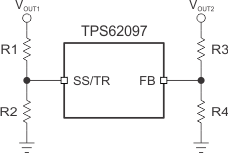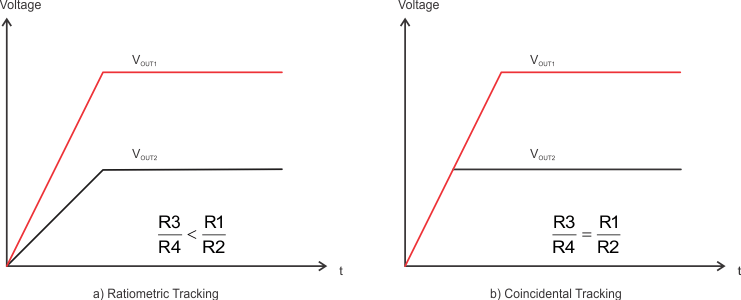ZHCSMN1A December 2015 – January 2021 TPS62097
PRODUCTION DATA
- 1 特性
- 2 应用
- 3 说明
- 4 Revision History
- 5 Device Options
- 6 Pin Configuration and Functions
- 7 Specifications
- 8 Detailed Description
- 9 Application and Implementation
- 10Power Supply Recommendations
- 11Layout
- 12Device and Documentation Support
- 13Mechanical, Packaging, and Orderable Information
8.4.4 Voltage Tracking (SS/TR)
The SS/TR pin is externally driven by another voltage source to achieve output voltage tracking. The application circuit is shown in Figure 8-2. From 0 V to 0.8 V, the internal reference voltage to the internal error amplifier follows the SS/TR pin voltage. When the SS/TR pin voltage is above 0.8 V, the voltage tracking is disabled and the FB pin voltage is regulated at 0.8 V. The device achieves ratiometric or coincidental (simultaneous) output tracking, as shown in Figure 8-3.
 Figure 8-2 Output Voltage Tracking
Figure 8-2 Output Voltage Tracking Figure 8-3 Voltage Tracking Options
Figure 8-3 Voltage Tracking OptionsThe R2 value should be set properly to achieve accurate voltage tracking by taking 7.5 µA soft start-up current into account. 1 kΩ or smaller is a sufficient value for R2.
For decreasing SS/TR pin voltage, the device does not sink current from the output when the device is in PSM, so the resulting decreases of the output voltage can be slower than the SS/TR pin voltage if the load is light. When driving the SS/TR pin with an external voltage, do not exceed the voltage rating of the SS/TR pin which is VIN + 0.3 V.